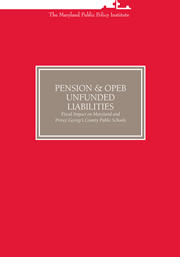Pension & OPEB Unfunded Liabilities
Fiscal Impact on Maryland and Prince George's County Public Schools
Executive Summary
 How easily could your family budget absorb an unexpected $10,130 increase to your credit card obligations? In effect, every household in Prince George’s County, Maryland owes that amount of money—sight unseen—to cover the costs of its school system’s other post-employment benefits (OPEB), or more specifically, unfunded OPEB liabilities for retiree benefits in the amount of $3.1 billion.
How easily could your family budget absorb an unexpected $10,130 increase to your credit card obligations? In effect, every household in Prince George’s County, Maryland owes that amount of money—sight unseen—to cover the costs of its school system’s other post-employment benefits (OPEB), or more specifically, unfunded OPEB liabilities for retiree benefits in the amount of $3.1 billion.
In addition, the state’s Maryland State Retirement and Pension System (MSRPS) has been inadequately funded for decades, and as of 2016, has $20 billion in unfunded pension liabilities, of which $1.4 billion (7 percent) is attributed to Prince George’s County Public Schools (PGCPS) for teachers’ and employees’ pensions.
An unfunded pension liability amount of $1.4 billion is the equivalent amount of 42 years of 3 percent salary increases for PGCPS staff—so it is significant. Although this PGCPS unfunded pension liability is “booked” by the state, and not PGCPS, this amount still impacts the state’s ability and political will to adequately fund county K-12 education, while also catching up on past unfunded pension liabilities.
Economically, Maryland ranks well when compared to other states, with the highest state median income in FY 2016, at $75,847; and the second-lowest poverty rate.2 However, the Mercatus Center at George Mason University ranked Maryland 37th-worst in state fiscal health, based on FY 2013 data, and 46th-worst based on FY 2015 data.3 This negative trend has significant implications for fixing excessive unfunded pension and OPEB liabilities.
Neither PGCPS’s $3.1 billion in unfunded OPEB liability, nor its $1.4 billion share of unfunded pension liability, can be addressed through short-term budget cuts within the school system without undermining the quality of educational services:
- The average teacher receives a salary and benefit package of $94,232 in FY 2018. The total unfunded OPEB liability eclipses teacher pay at $282,596 per teacher. It would take the school system 10 years to fund its OPEB obligations if it reduced teacher compensation by $28,000 per teacher per year.
- The district would have to reduce teaching staff by 1,921 teachers to close the OPEB liability, or 21 percent of the district’s teachers. Reducing teachers by this amount would increase class sizes from 14.7:1 to 18.7:1.
Nearly all states have challenges with unfunded pension and OPEB liabilities. The most common fix for excessive unfunded pension and OPEB liabilities is to exercise strict fiscal discipline over 20 to 30 years, set a funding goal, and fund to that goal consistently —regardless of what is going on in the economy and in the legislature. That discipline must be backed up by establishing meaningful rainy-day funds at the state and county levels. All Maryland actions taken to date have been insufficient.
Among all states, Maryland is ranked 16th in trust fund solvency—above average—despite its $20 billion unfunded pension liability.4 Projections of recent past fiscal behavior, however, based solely on actual fiscal outcomes, indicate that Maryland is falling further behind in pension funding, and PGCPS will not likely reduce its $3.1 billion unfunded OPEB liability by one-fourth by FY 2026. PGCPS will not likely be on target for a reasonable amount of unfunded OPEB liability within 30 years, unless more aggressive funding measures are executed consistently.
Maryland fully funded the MSRPS in FY 2000 (101 percent). But it has since failed to fully fund the MSRPS, resulting in only 70.5 percent funding as of FY 2016. Without increased financial stewardship, the state’s unfunded liability could grow to $40 billion by FY 2026, or only 56.8 percent of the funds needed to meet its pension obligations. Based solely on past actual fiscal experience, by FY 2026:
Worst Case
- MSRPS 56.8% funded, 43.2% unfunded
- $40.0 billion in unfunded liabilities
Best Case
- MSRPS 77.6% funded, 22.4% unfunded
- $20.5 billion in unfunded liabilities
Conclusion
More aggressive pension funding action is needed to assure that unfunded liabilities are reasonably reduced. Maryland needs to expand rainy-day funds specifically for its commitments to reduce unfunded liabilities and as a cushion for downturns.
Not addressing the problem now only makes the future worse for education, current students, taxpayers, and the next generation of students.
1 The full analysis supporting this executive summary is contained in a PowerPoint document, named (in part), “Past due:Pension-OPEB analysis.”
2 The Huffington Post, “America’s richest (and poorest) states,” September 15, 2016, www.huffingtonpost.com/entry/americas-richest-and-poorest-states_us_57db167be4b04fa361d99639
3 Eileen Norcross and Olivia Gonzalez, “Ranking the states by fiscal condition,” Mercatus Center, George Mason University, 2017, www.mercatus.org/system/files/norcross-fiscalrankings-2017-mercatus-v1.pdf
4 Ibid.





